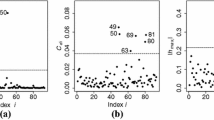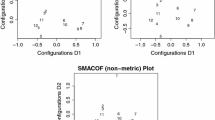Abstract
The semivariogram, which measures the spatial variability between experimental data, is generally used as a structural input in all two-point geostatistical procedures. However, in most geoscience applications, experimental semivariograms are usually computed from a limited number of sparsely spaced measurements, which results in uncertainty associated with the semivariance values estimated for a specified number of lags. More importantly, considering a spatial variable modelled by a nonstationary random field, uncertainty is not only in the experimental semivariogram of the residuals, but also in the coefficients of the drift model estimated from the available experimental data. Therefore, when assessing the reliability of an experimental semivariogram (or estimated semivariances) in the nonstationary case, both aforementioned uncertainties should be taken into account. The aim of this paper is to extend the “Generalised Bootstrap” procedure to the nonstationary model by propagating the uncertainty associated with the estimated drift coefficients into the uncertainty in the experimental semivariogram of the residuals. The proposed methodology is demonstrated in a case study using abundant geophysical measurements characterised by a nonstationary random function. Two scenarios are evaluated in the case study: (1) it is assumed that the drift coefficients can be estimated without any uncertainty, and (2) uncertainty of the drift coefficients is taken into account. We have explained the methodology that allows to assess the uncertainty of the semivariogram lag estimates in the presence of the drift in the mean. Considering the second scenario, uncertainty is obviously larger than the case where uncertainty of the drift in the mean is ignored. This evaluation should be considered in applications where the data is often rather limited, such as subsurface hydrology (i.e. porosity, transmissivity), soil science (i.e. heavy metal content, soil moisture) and mining (i.e. scoping or pre-feasibility stage of the project). In fact, modern geostatistics should provide not only the semivariogram estimates but also estimation of its uncertainty.







Similar content being viewed by others
References
Akaike, H. (1974). A new look at the statistical model identification. IEEE Transactions on Automatic Control, AC–19(6), 716–723.
Armstrong, M. (1984). Problems with universal kriging. Mathematical Geology, 16(1), 101–108.
Chilès, J. P., & Delfiner, P. (2012). Geostatistics: Modeling spatial uncertainty (2nd ed.). New York: Wiley.
Chun, Y., & Griffith, D. (2013). Spatial statistics and geostatistics: Theory and applications for geographic information science and technology. Thousand Oaks: Sage.
Dagasan, Y., Erten, O., Renard, P., Straubhaar, J., & Topal, E. (2019). Multiple-point statistical simulation of the ore boundaries for a lateritic bauxite deposit. Stochastic Environmental Research and Risk Assessment, 33(3), 865–878.
Dagasan, Y., Renard, P., Straubhaar, J., Erten, O., & Topal, E. (2018a). Automatic parameter tuning of multiple-point statistical simulations for lateritic bauxite deposits. Minerals, 8(5), 220.
Dagasan, Y., Renard, P., Straubhaar, J., Erten, O., & Topal, E. (2018b). Pilot point optimization of mining boundaries for lateritic metal deposits: Finding the trade-off between dilution and ore loss. Natural Resources Research, 28(1), 153–171.
Deutsch, C.V. (2004). A statistical resampling program for correlated data: Spatial bootstrap. In Center for computational geostatistics annual report papers.
Diggle, P. J., & Ribeiro, P. J, Jr. (2007). Model-based geostatistics. New York: Springer.
Dowd, P. A., & Pardo-Igúzquiza, E. (2005). Estimating the boundary surface between geologic formations from 3D seismic data using neural networks and geostatistics. Geophysics, 70(1), 1–11.
Dowd, P. A., & Pardo-Igúzquiza, E. (2012). Geostatistics Oslo 2012, quantitative geology and geostatistics 17. In P. Abrahamsen, R. Hauge, & O. KolbjØrnsen (Eds.), Extensions of the parametric inference of spatial covariances by maximum likelihood (pp. 129–141). Berlin: Springer.
Efron, B. (1979). Bootstrap methods: Another look at the Jackknife. The Annals of Statistics, 7(1), 1–26.
Erten, O. (2012). Profiling and mining control to mitigate dilution effect from \(SiO_{2}\) at the base of a bauxite deposit. PhD thesis, The University of Queensland.
Erten, O., Kizil, M. S., Topal, E., & McAndrew, L. (2013). Spatial prediction of lateral variability of a laterite-type bauxite horizon using ancillary ground-penetrating radar data. Natural Resources Research, 22(3), 207–227.
Erten, O., McAndrew, L., Kizil, M., & Topal, E. (2015). Incorporating fine-scale ground-penetrating radar data into the mapping of lateral variability of a laterite-type bauxite horizon. Transactions of the Institutions of Mining and Metallurgy, Section A: Mining Technology, 124(1), 1–15.
Garrido, M., Navarro, F., Ortiz, J., & Moreira, J. (2016). Resource assessment with unfolding methodology: A case study. In J. Barros (Ed.), 6th International conference on innovation in mine operations (MININ2016). Santiago: Gecamin Publications.
Jassim, F. A., & Altaany, F. H. (2013). Image interpolation using kriging technique for spatial data. Canadial Journal on Image Processing and Computer Vision, 4(2), 16–21.
Journel, A. G., & Huijbregts, C. J. (1978). Mining geostatistics. London: Academic press.
Kalbfleisch, J. G. (1979). Probability and statistical inference II. New York: Springer.
Kitanidis, P. K. (1983). Statistical estimation of polynomial generalized covariance functions and hydrologic applications. Water Resources Research, 19, 909–921.
Mardia, K. V., & Marshall, R. J. (1984). Maximum likelihood estimation of models for residual covariance in spatial regression. Biometrika, 71(1), 135–146.
Mariethoz, G., & Caers, J. (2014). Multiple-point geostatistics: Stochastic modeling with training images. Chichester: Wiley.
Matheron, G. (1971). The theory of regionalized variables and its applications. Les Cahiers du Centre de Morphologie Mathématique de Fontainebleau, No. 5. Fontainebleau: École Nationale Supérieure des Mines de Paris.
McCullagh, P., & Nelder, J. A. (1989). Generalized linear models (2nd ed.). London: Chapman & Hall.
Olea, R. A. (1999). Geostatistics for engineers and earth scientists. Norwell: Kluwer Academic Publishers.
Olea, R. A. (2006). A six-step practical approach to semivariogram modeling. Stochastic Environmental Research and Risk Assessment, 20(5), 307–318.
Olea, R. A., & Pardo-Igúzquiza, E. (2011). Generalized bootstrap method for assessment of uncertainty in semivariogram inference. Mathematical Geosciences, 43(2), 203–228.
Ortiz, J., & Deutsch, C. V. (2002). Calculation of uncertainty in the variogram. Mathematical Geology, 34(2), 169–183.
Pardo-Igúzquiza, E. (1997). MLREML: A computer program for the inference of spatial covariance parameters by maximum likelihood and restricted maximum likelihood. Computers & Geosciences, 23(2), 153–162.
Pardo-Igúzquiza, E., Chica-Olmo, M., & Atkinson, P. M. (2006). Downscaling cokriging for image sharpening. Remote Sensing of Environment, 102(1–2), 86–98.
Pardo-Igúzquiza, E., & Dowd, P. A. (1998a). A case study of model selection and parameter inference by maximum likelihood with application to uncertainty analysis. Nonrenewable Resources, 7(1), 63–73.
Pardo-Igúzquiza, E., & Dowd, P. A. (1998b). The second-order stationary universal kriging model revisited. Mathematical Geology, 30(4), 347–378.
Pardo-Igúzquiza, E., & Dowd, P. A. (2001a). Variance–covariance matrix of the experimental variogram: Assessing variogram uncertainty. Mathematical Geology, 33(4), 397–419.
Pardo-Igúzquiza, E., & Dowd, P. A. (2001b). VARIO2GD: A computer program for estimating the variogram and its uncertainty. Computers & Geosciences, 27(5), 549–561.
Pardo-Igúzquiza, E., & Dowd, P. A. (2003). Assessment of the uncertainty of spatial covariance. Soil Science, 168(11), 769–782.
Pardo-Igúzquiza, E., & Olea, R. A. (2012). VARBOOT: A spatial bootstrap program for semivariogram uncertainty assessment. Computers & Geosciences, 41, 188–198.
Solow, A. R. (1985). Bootstrapping correlated data 1. Mathematical Geology, 17(7), 769–775.
Acknowledgments
This paper completed a mandatory internal review by the US Geological Survey (USGS) before final submission to the journal (http://pubs.usgs.gov/circ/1367/). We wish to express our gratitude to Özgen Karacan (USGS) and Julián Ortiz (Queen’s University, Ontario) for suggestions leading to improvements to a first version of the manuscript. Any use of trade, firm, or product names is for descriptive purposes only and does not imply endorsement by the US Government.
Author information
Authors and Affiliations
Corresponding author
Appendix A. The Steps of the Generalised Bootstrap Algorithm for the Spatial Variable Modelled by a Nonstationary Random Function
Appendix A. The Steps of the Generalised Bootstrap Algorithm for the Spatial Variable Modelled by a Nonstationary Random Function
The workflow of the generalised bootstrap procedure adapted to the semivariogram uncertainty assessment in the nonstationary case is described as follows:
- 1.
Consider n spatial data \(\{z({\mathbf{u }}_i);\;i=1,\ldots ,n\}\) modelled by a nonstationary random function. First, model the drift \(m({\mathbf{u }})\) as a low-order polynomial (i.e. the drift order 1 or linear model) and estimate its coefficients \(\hat{\varvec{\upbeta }}=[{\hat{\beta }}_{1},{\hat{\beta }}_{2},{\hat{\beta }}_{3}]\) by the ML approach.
- 2.
Generate L sets of drift \(\hat{\varvec{\upbeta }}_{l}=[{\hat{\beta }}^{l}_{1},{\hat{\beta }}^{l}_{2},{\hat{\beta }}^{l}_{3}]\), \(\{l=1,\ldots ,L\}\) with different likelihoods by discretising the parameter space of the drift coefficients estimated by the ML approach.
- 3.
Select P sets of plausible drift models (or as defined by its coefficients) \(\hat{\varvec{\upbeta }}_{l}=[{\hat{\beta }}^{l}_{1},{\hat{\beta }}^{l}_{2},{\hat{\beta }}^{l}_{3}]\) with \(\{l=1,\ldots ,P<L\}\) within the \(95\%\) CR using the likelihood ratio statistic.
- 4.
Calculate P corresponding sets of residual data \(\{r^{p}({\mathbf{u }}_i), i=1,\ldots ,n\;\text {and}\;p=1,\ldots ,P\}\).
- 5.
For each set, transform residual data \(r^{p}({\mathbf{u }}_i)\) to normal (Gaussian) scores \(y^{p}({\mathbf{u }}_{i})=\varphi (r^{p}({\mathbf{u }}_{i}))\) with mean 0 and variance 1.
- 6.
For each set, model the experimental semivariogram \({\hat{\gamma }}_{p}({\mathbf{h}})\) of the Gaussian residuals \(\{y^{p}({\mathbf{u }}_i),i=1,\ldots ,n\;\text {and}\;p=1,\ldots ,P\}\) and obtain the covariance model \(C_{p}({\mathbf{h}})\).
- 7.
Calculate the \(n\times n\) variance-covariance matrix \(C_{p}\) from the covariance model \(C_{p}({\mathbf{h}})\) of each set of the Gaussian residual data \(y^{p}({\mathbf{u }}_i)\).
- 8.
Perform a decomposition of the covariance matrix \(C_{p}({\mathbf{h}})\) by the LU factorisation as the product of a lower triangular matrix and upper triangular matrix (which is the transpose of the lower triangular), \(C_{p}({\mathbf{h}})={\mathbf{LL}} ^T\), where \({\mathbf{L }}\) is an \(n\times n\) lower triangular matrix.
- 9.
Generate a set of n independent, identically distributed (idd) samples as \({\tilde{y}}^{p}({\mathbf{u }}_{i})={\mathbf{L }}^{-1}\;y^{p}({\mathbf{u }}_{i})\).
- 10.
Check the decorrelation of each set of idd residual data \({\tilde{y}}^{p}({\mathbf{u }}_{i})\). The null hypothesis is true when the data \({\tilde{y}}^{p}({\mathbf{u }}_{i})\) are uncorrelated.
- 11.
Create a bootstrap resample \({\tilde{y}}^{*(p)}({\mathbf{u }}_{i})\) from the decorrelated data \({\tilde{y}}^{p}({\mathbf{u }}_{i})\).
- 12.
The Gaussian resamples that are correlated are obtained as \(y^{*(p)}({\mathbf{u }}_{i})={\mathbf{L }}\;{{\tilde{y}}^{*(p)}({\mathbf{u }}_{i})}\).
- 13.
The normal scores of each set of resamples are backtransformed by the inverse transformation function:
\(r^{*(p)}({\mathbf{u }}_{i})= \varphi (y^{*(p)}({\mathbf{u }}_{i}))^{-1}\)
- 14.
Repeat steps \(11-13\) to create 2000 bootstrap resamples \(\{r^{*(p)}_{\alpha }({\mathbf{u }}_i)\;i=1,\ldots ,n\;;\;p=1,\ldots ,P\;\text {and}\;\alpha =1,\ldots ,2000\}\) for each set of residual data.
- 15.
Combine all resamples \(r^{*(p)}_{\alpha }({\mathbf{u }}_i)\) according to the ratio between the probability of the particular drift coefficients and the probability of the drift coefficients estimated by the ML approach (see Section ).
- 16.
Estimate the experimental semivariogram \({\hat{\gamma }}^{*(p)}_{\alpha }({\mathbf{h}})\) of the selected residual resamples from step 15.
- 17.
Calculate bootstrap histograms of the estimated semivariance values for each lag \(\{{\hat{\gamma }}^{*(p)}_{\alpha }(h_j);\;j=1,\ldots ,J\}\) from the pooled set of models and quantify the uncertainty as CIs (i.e. \(68\%\), \(90\%\) and \(95\%\)) for the \(j{\text {th}}\) lag.
- 18.
End.
Rights and permissions
About this article
Cite this article
Erten, O., Pardo-Igúzquiza, E. & Olea, R.A. Assessment of Experimental Semivariogram Uncertainty in the Presence of a Polynomial Drift. Nat Resour Res 29, 1087–1099 (2020). https://doi.org/10.1007/s11053-019-09496-3
Received:
Accepted:
Published:
Issue Date:
DOI: https://doi.org/10.1007/s11053-019-09496-3




